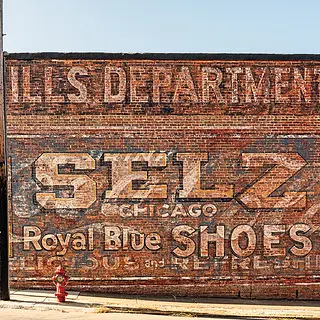
Faded Glory: The Restored Ghost Signs of Mooresville, North Carolina
There’s something audacious about a ghost sign, even when it’s so faded you can barely read it. It took chutzpah for companies to commandeer entire walls of buildings so they could advertise their wares from the late 1800s through the mid-1900s. Entire generations of sign artists were trained in hand-lettering techniques, practicing a trade that blurred the line between art and craft. As other forms of advertising grew more popular, the market for wall paintings shrank, and today their delicate remains grace the sides of older brick buildings all over the country.

The lettering on the Goodman Drugs parking arrow was barely visible before its restoration, according to Mooresville planner Tim Brown. “Scott and Jeremy discovered the wording of that sign from staring at it for hours,” he says. “We were absolutely thrilled.”
Jeremy Russell and Scott Allred have picked up where the sign painters of the past left off. The Asheville, North Carolina–based duo is known for its new mural designs, inspired in part by ghost signs. A couple of years ago, they began exploring ways to restore old signs and keep their vintage look, rather than the more typical strategy of repainting them to look new. “We started developing a technique where we could bring back the sign 20 percent, or 50 percent,” says Allred. “It doesn’t disappear, but it still feels old and authentic.”
Earlier this year, the North Carolina town of Mooresville—a Main Street America community about 45 minutes north of Charlotte—gave them a chance to test this technique. Russell and Allred, whose company is called Brushcan Custom Murals & Hand-Painted Signs, were asked to restore three signs in the Mooresville Commercial Core Historic District. They started with deep observation and research, trying to learn as much as possible about the original signs. Locals, including staff members at The Mooresville Museum, provided valuable historical context, and archived newspaper ads supplied additional clues.

“Kelly Clothing was a little tough at first, because it was almost completely gone,” Scott Allred says. “By getting on a lift, we were able to identify the style of lettering and the man in the middle.”

A view of downtown Mooresville, a Main Street America community.

The J.P. Mills Department Store/Selz Shoes sign was made between 1890 and 1920, with the Coca-Cola sign on top of it coming later. "All that history becomes the background of the city," says Russell.

Allred and Russell's signature.
Russell and Allred cleaned the historic signs and sealed them with an acrylic urethane finish. Then they began painting—restoring just enough to make the signs easily readable but retain their vintage look. Ghost signs are more complicated up close than they appear from the street, containing layers of color and intricate brushwork. “For example, in the 1920s and ’30s, people were mixing their own paint,” says Russell. “If you have green paint, some of the blue and yellow pigments will separate out over time, and you’ll see little dots of yellow and blue. We re-create that.”
The process takes time and extreme attention to detail; if a sign is too uniform, the impression of natural weathering will be lost. “Say there’s a downspout where water has been running for a number of years,” Allred says. “The paint will be worn away there.” He and Russell often preserve those imperfections, rather than painting over them. Once their painting work is done, they apply a UV-protective varnish with a flat finish.

photo by: Evan Kafka
Scott Allred (left) and Jeremy Russell (right), shown in their Asheville, N.C., studio, had already been painting together for years before they formed Brushcan Custom Murals & Hand-Painted Signs in 2014.
The results of their work in Mooresville, a town of about 38,000, have pleased residents. “It definitely adds to the historic backdrop of our downtown,” says Kim Atkins, executive director of the Mooresville Downtown Commission, an affiliate member of Main Street America. Tim Brown, a municipal planner who helped make the project happen, agrees. “There’s a real sense of pride, support, and advocacy for restoring these signs in general,” he says. Brown garnered support from various committees, ultimately convincing the town’s board of commissioners to fund the restoration of the three murals, which are shown on the following pages.
He hopes to bring Brushcan back to conserve more historic signs in Mooresville, including a Wrigley’s Spearmint gum sign. Meanwhile, Russell and Allred have just completed their second historic sign restoration project, in Pikeville, Kentucky (also a Main Street America community). “There’s so much digital technology, TV, movies, and stuff that’s out there now,” says Russell. “This is an old-school thing you can preserve. I think people get excited about that.”
The Mooresville Downtown Commission is an affiliate member of Main Street America, a program of the National Trust for Historic Preservation.



